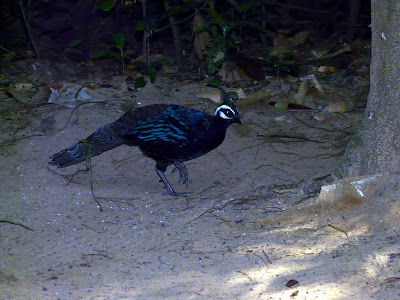OK. Just before I returned from the Philippines, I managed to scan my emails and noted a message letting me know that a Little Crake had been found on what is effectively my local patch, Exminster Marshes. I was texted by another friend whilst in the air, so my first greeting - at 5.30 a.m. on the apron at Heathrow - was that the crake was showing nicely. Urgh. I happen to be very fond of crakes & rails, as they are a nice blend of the enigmatic, elusive and good-looks, as a rule. Little Crake is not only one of the nice ones, but it also happens to be the first record for mainland Devon, so I was honour-bound to go and see it!
I duly trotted down the marshes on Saturday morning and was pleasantly surprised to see only four or five cars in the carpark and about 20 people at the relevant corner of the road, but the crake wasn't showing. As we waited, patiently, the number of people swelled to some 60-70 until the bird was noticed wandering blithely along a ditch behind a hedge. I wandered quietly up to the hedge, peered over the shoulder of the guy in front and gained my Devon tick, UK tick, whatever else you want to view it as. I then thought it would be a good idea to move out of the way,
quietly down the track until I could see clearly and wait for the bird to come past, perhaps getting a photo. The bird co-operated to a point; that point being about half-way between the two gaps, when everyone else realised it was headed my way - at which time about 40 people clumped, clattered, stumbled and rattled their way along the track
en masse, spooking the bird into the reeds...
Fast-forward. Sunday, I headed up to north Devon for another look at the King Eider and to look for Spoonbill - my friend Judith has something of a spoonbill fetish and hadn't seen the eider, so she was keen to pick both species up. We trotted along the coast for a while to look for Spoonbill whilst the tide rose, so that the eider would be reasonably close to view when we got there. Eventually we got round to Northam Burrows, parked up and scanned for the duck - picked it up quickly, asleep bum-on on the sand a couple of hundred metres ahead of us. I moved the car up the road until we were parallel, looked up with the bins and realised it was flying off. Why? Another birder had decided to walk straight out across the sand, scope across shoulder, until he was as close as humanly possible to the bird, perhaps in case he thought it was plastic - I don't know. Given that the bird was in photo range from the road, we felt this was a tad unnecessary and a few choice expletives were aired as the bird headed up towards Barnstaple, not to be seen again that day.
Fast-forward. Again. This morning (Tuesday), I went back for more peaceful views of the crake. Again I tried to avoid the crowds and watch the bird undisturbed by crouching quietly in the shadow of a decent-sized oak and moving no more than necessary, and again was foiled by the inability of other observers to shut the **** up and walk quietly. Eventually I managed some good views and some half-decent photos, but even then the constant background yabber about teleconverters, lenses and scope envy took some of the gloss off the bird. It did, however, make me appreciate that however difficult the birding was in the Philippines, there were far fewer tick-hungry tossers with no pretence at fieldcraft...
Now that's off my chest, here's a picture of the crake...:

Adult male Little Crake (
Porzana parva)
P.S. My irritation is tempered by the fact that I/we saw all the birds in question, eventually, along with a bonus group of five Cattle Egret. Had we missed out, I'd have been a little more ratty...!
 ...this! Swan carnage on one bank of a reprofiled ditch. Still 40-odd hanging around, so not a great problem in the grand scheme of things.
...this! Swan carnage on one bank of a reprofiled ditch. Still 40-odd hanging around, so not a great problem in the grand scheme of things.












